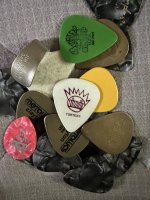Bricksnbeatles
Member known well
Strap on that Jammypac, because this one has the brownness to satiate the mighty Boognish himself…
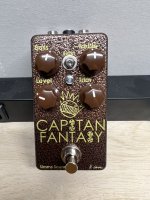
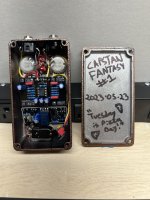
This pedal is of course a clone of the MidFi Demo Tape Fuzz (built on a PedalPCB B-Side Fuzz PCB, with some mods that we’ll address later), which itself is a direct adaptation of the preamp in a single input channel of a Tascam Portastudio tape recorder. As a big ween fan, it seemed only fitting to theme this build around them, as their early independently released cassette-only releases on the Bird O’ Pray label, as well as their 2nd and 3rd official studio efforts, 1991’s The Pod (Shimmy-Disc), and 1992’s Pure Guava (Elektra) were primarily recorded by the duo using Tascam 4-track cassette recorders.
This build differs from the stock circuit most notably in two ways:
First, the B25K ‘Trim’ control has been replaced with a C25K potentiometer to allow more exploration of the clean-ish and edge-of-breakup tones, since when I breadboarded the circuit a few months ago, I found that the stock linear taper sounded mostly the same everywhere past 11:00, and despite that thick janky fuzz being the namesake of the original pedal, the slightly-saturated and heavily colored cleans, and the rich overdrives of the lower half of the pot’s values are much more exciting to me.
Secondly, a switchable JFET buffer has been tacked onto the input to solve the potential issue of the circuit being incredibly muddy at low gain or with certain pickups (I say *potential* issue because it’s authentic to the portastudio sound, and keeping the buffer switched off when using the pedal as a preamp for DI recording is a quick way to get the portastudio experience from a DAW.) or when recording with a microphone or piezos to get everything agreeable. The buffer also really gooses the range of the EQ, and tightens up the attack of the fuzzy settings when you have the trim all the way up.
I also gave this fella relay bypass, which was a last minute decision since it’ll probably be used as a desktop preamp for recording just as often as it’ll be on the floor, and a momentary switch is so much nicer to push with a thumb than a clunky 3pdt!
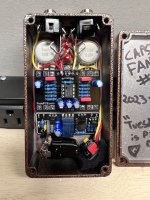
Now, to explain the artwork:
First off, the name Capstan Fantasy comes from the fan-favorite glam/punk eighth track on The Pod and live staple, Captain Fantasy— but since it’s a cassette recorder preamp, captain becomes capstan… hopefully I don’t have to explain beyond that. The S’s are designed as tape heads with tape spanning them to keep with the theme. The knob labeling is all done in Helvetica and justified to be flush with the left bound of each knob, as a nod to the UI of the Portastudio range. Centrally above the titular label is a portrait of Ween’s trickster spirit himself, Boognish. In a dark brown shade that just barely distinguishes itself from the hammered copper powdercoat (in future versions of this build, I’ll make it a smidge darker so it stands out a bit more), the background is adorned with William Tucker’s artwork from Ween’s second Bird O’ Pray cassette release, 1988’s Ween II: Axis Bold as Boognish.
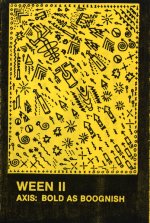
A demo is currently pending— I want to record a full song in the style of Pod-era Ween with the Capstan Fantasy as the preamp for each track (guitars, bass, Vox, drum machine) to keep the experience as authentic as possible, but I haven’t written anything yet. On top of that, the build currently has the issue of being microphonic as hell (and pretty noisy, but I think that’s a side effect of the microphonics) with dual resonances at F#3 and G#3, which it wasn’t until I boxed it up, but I don’t feel like probing around to find the culprit at the moment (the only ceramic cap is in the buffer, and that’s effectively non-existent once it’s switched out of the circuit) since this is in a 1590B, which was kind of fiddly to work in given the addition of the relay board and buffer board. Prime suspects at the moment are the IC and the relay. Once I get that worked out and get a song written I’ll get the demo recording together as quickly as possible!


This pedal is of course a clone of the MidFi Demo Tape Fuzz (built on a PedalPCB B-Side Fuzz PCB, with some mods that we’ll address later), which itself is a direct adaptation of the preamp in a single input channel of a Tascam Portastudio tape recorder. As a big ween fan, it seemed only fitting to theme this build around them, as their early independently released cassette-only releases on the Bird O’ Pray label, as well as their 2nd and 3rd official studio efforts, 1991’s The Pod (Shimmy-Disc), and 1992’s Pure Guava (Elektra) were primarily recorded by the duo using Tascam 4-track cassette recorders.
This build differs from the stock circuit most notably in two ways:
First, the B25K ‘Trim’ control has been replaced with a C25K potentiometer to allow more exploration of the clean-ish and edge-of-breakup tones, since when I breadboarded the circuit a few months ago, I found that the stock linear taper sounded mostly the same everywhere past 11:00, and despite that thick janky fuzz being the namesake of the original pedal, the slightly-saturated and heavily colored cleans, and the rich overdrives of the lower half of the pot’s values are much more exciting to me.
Secondly, a switchable JFET buffer has been tacked onto the input to solve the potential issue of the circuit being incredibly muddy at low gain or with certain pickups (I say *potential* issue because it’s authentic to the portastudio sound, and keeping the buffer switched off when using the pedal as a preamp for DI recording is a quick way to get the portastudio experience from a DAW.) or when recording with a microphone or piezos to get everything agreeable. The buffer also really gooses the range of the EQ, and tightens up the attack of the fuzzy settings when you have the trim all the way up.
I also gave this fella relay bypass, which was a last minute decision since it’ll probably be used as a desktop preamp for recording just as often as it’ll be on the floor, and a momentary switch is so much nicer to push with a thumb than a clunky 3pdt!

Now, to explain the artwork:
First off, the name Capstan Fantasy comes from the fan-favorite glam/punk eighth track on The Pod and live staple, Captain Fantasy— but since it’s a cassette recorder preamp, captain becomes capstan… hopefully I don’t have to explain beyond that. The S’s are designed as tape heads with tape spanning them to keep with the theme. The knob labeling is all done in Helvetica and justified to be flush with the left bound of each knob, as a nod to the UI of the Portastudio range. Centrally above the titular label is a portrait of Ween’s trickster spirit himself, Boognish. In a dark brown shade that just barely distinguishes itself from the hammered copper powdercoat (in future versions of this build, I’ll make it a smidge darker so it stands out a bit more), the background is adorned with William Tucker’s artwork from Ween’s second Bird O’ Pray cassette release, 1988’s Ween II: Axis Bold as Boognish.

A demo is currently pending— I want to record a full song in the style of Pod-era Ween with the Capstan Fantasy as the preamp for each track (guitars, bass, Vox, drum machine) to keep the experience as authentic as possible, but I haven’t written anything yet. On top of that, the build currently has the issue of being microphonic as hell (and pretty noisy, but I think that’s a side effect of the microphonics) with dual resonances at F#3 and G#3, which it wasn’t until I boxed it up, but I don’t feel like probing around to find the culprit at the moment (the only ceramic cap is in the buffer, and that’s effectively non-existent once it’s switched out of the circuit) since this is in a 1590B, which was kind of fiddly to work in given the addition of the relay board and buffer board. Prime suspects at the moment are the IC and the relay. Once I get that worked out and get a song written I’ll get the demo recording together as quickly as possible!


